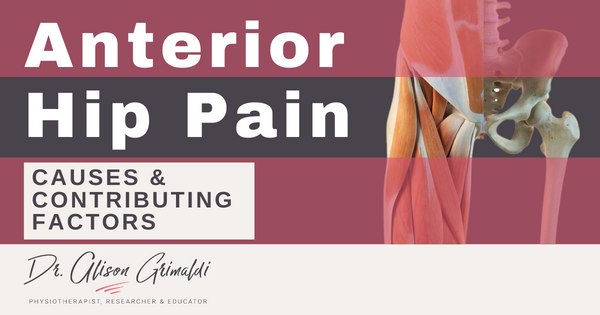Hip Tip 9 – But please stop stretching
Can't make the workshop? Do the Online Course

Day 9: The 9th of 12 Hip Tips today and the last of the tips on exercise interventions. On day 7, I talked about why health and exercise professionals SHOULD NOT use the clam exercise and yesterday we discussed why health and exercise professionals SHOULD include hip flexor exercises for those with anterior hip and groin pain. But the type of exercise prescribed for the hip flexors is important, as we'll chat about today.
Tip #9 But please stop stretching those hip flexors! At least for those with Hip Pain
As I highlighted in yesterday's blog, hip flexor conditioning is often omitted in exercise programs for hip and groin pain. When hip flexors are addressed, most frequently the exercise is in fact a passive stretch with no active conditioning involved. Certainly you will see plenty of patients who have reduced hip extension range of motion, but prescribing stretches for those with anterior hip pain may be counter-productive. Let's take a look at why...

Considerations for prescription of Hip Flexor Stretching
1. Does your patient actually have restricted hip extension range?
It's important not to assume that someone has restricted hip extension range simply because they are not using this range during functional tasks such as gait. For those presenting with intra or extra-articular related anterior hip pain, this is usually an antalgic avoidance rather than true restriction, as we talked about in yesterday's blog.
Sure, in true 'use-it-or-lose-it ' fashion, prolonged avoidance of this range is likely to result in soft tissue shortening for most, but you can't assume. You need to assess the range of hip extension. How will you achieve an objective measure of hip extension range that you are confident is reliable and meaningful? Hip extension range is most commonly measured in a modified Thomas test position, but how do you standardise and interpret this measurement in your own clinical practice?
- Do you get the patient to hold the non-test leg to their chest?
- What happens if they can't comfortably achieve this position - particularly on the painful side?
- What do you consider to be 'normal'? ... horizontal thigh? 10 degrees of extension?
- Do you account for pelvic position and alter your expectation?
- How do you measure the range of hip extension in a reproducible manner that can be tested over time to determine effectiveness of interventions to improve hip flexor length?
The literature on this topic is very poor, most studies failing to adequately controlling pelvic position. Beneck and colleagues demonstrated that, for females, lack of stabilisation of the pelvis significantly influences the range of hip extension measured on the basis of thigh position1.
Even if you're confident that you have i) collected a reliable and meaningful measure of hip extension and ii) it appears to be restricted, it does not naturally follow that passive stretching will be the answer.
2. Will hip flexor stretching be helpful for those with anterior hip pain ?
a. Will hip flexor stretching improve anterior hip pain?
I am not aware of any high-quality evidence that passive stretching of the hip flexors has a positive effect on anterior hip pain, but of course if you have performed or come across some great research on this topic, please feel free to let me know here.
b. Will hip flexor stretching provide meaningful and lasting improvements in hip extension range?
There are a couple of studies that have shown short-term increases in hip extension range after weeks of regular passive stretching2,3. However, these were in painfree populations and no longer term measures were collected.
3. Will hip flexor stretching be harmful?
Maybe? A 'new cause' of direct anterior labral pathology (3 o'clock position) was suggested almost a decade ago - this was referred to as 'iliopsoas impingement' 4. A close relationship between the psoas tendon and the adjacent acetabular labrum was identified. Yoshio and colleagues had previously demonstrated that from 15 degrees of flexion, the psoas tendon articulates with the anterior aspect of the hip joint5. As the hip moves from 15 degrees of flexion into extension, we can reasonably expect the compressive load of the psoas tendon at the anterior hip to incrementally increase, thereby increasing loads on the tendon itself and the structures situated between the tendon and the head of the femur - the bursa, the capsule and the anterior labrum.
It is possible that excessive exposure to these loads over time may produce or worsen pathology in these tissues, but the research has not provided clear evidence on this one. In those who already have painful anterior pathologies of the iliopsoas tendon, bursa and underlying joint structures, passive sustained hip flexor stretching has a high risk of causing pain provocation at a minimum.
Click on the box above to read Day 8 miniblog
Click on the box above to read Day 10 miniblog
Another great Anterior Hip Pain blog

Anterior Hip Pain: Causes & Contributing Factors
Adequate consideration of individual causes and contributing factors is important for best outcomes.
Sign up to our newsletter to receive updates on upcoming courses, news and special offers.
References
- Beneck, G., Selkowitz, D., Janzen, D., Malecha, E. and Tiemeyer, B., 2018. The influence of pelvic rotation on clinical measurements of hip flexion and extension range of motion across sex and age. Physical Therapy in Sport, 30, pp.1-7.
- Watt, J., Jackson, K., Franz, J., Dicharry, J., Evans, J. and Kerrigan, D., 2011. Effect of a Supervised Hip Flexor Stretching Program on Gait in Elderly Individuals. PM&R, 3(4), pp.324-329.
- Mettler, J., Shapiro, R. and Pohl, M., 2019. Effects of a Hip Flexor Stretching Program on Running Kinematics in Individuals With Limited Passive Hip Extension. Journal of Strength and Conditioning Research, 33(12), pp.3338-3344.
- Domb, B., Shindle, M., McArthur, B., Voos, J., Magennis, E. and Kelly, B., 2011. Iliopsoas Impingement: A Newly Identified Cause of Labral Pathology in the Hip. HSS Journal ®, 7(2), pp.145-150.
- Yoshio, M., Murakami, G., Sato, T., Sato, S. and Noriyasu, S., 2002. The function of the psoas major muscle: passive kinetics and morphological studies using donated cadavers. Journal of Orthopaedic Science, 7(2), pp.199-207.




